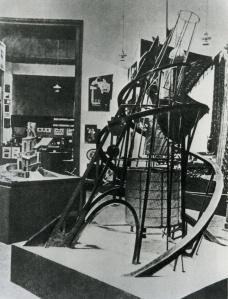Russian Constructivist Vladimir Tatlin’s Monument to the Third International model was assembled in 1920 with the intention of building it full-scale, which would have left other rival building in its shadows. The Russian monument planned to house government and administrative centers. Unfortunately, due to lack of materials and funds, the monument’s construction never took off.
Tatlin’s model was made of simple objects such as wire, wood, and other functional materials. The production of objects from simple materials reflected the ideals of Constructivism, which called for pieces that could still be viewed as art but could serve a function; they literally wanted to build, or construct, their works of art. Tatlin stated that he wanted to create “A union of purely artistic forms for a utilitarian purpose”[1]. In other words, he wanted to make art that could not only be viewed by people but could serve people.
The monument is full of straight and diagonal lines, yet makes a very dynamic movement upward. Tatlin was fascinated with movement in art, and exclaimed that, “It was to be dynamic, both in its outward form and inward activity”[2]. Movement was such an important aspect to Tatlin that he planned for each level of government and administrative office to literally move and revolve on an axis in the monument. While the monument exterior contains several simple, circular, geometric patterns, it has a very prominent asymmetry as it spirals upward. This imbalance and sense of almost uncontrollable movement gives the impression of feelings like rebellion and confidence; Tatlin wanted the building to put all other country’s monuments to shame, and felt he could do that by stepping out of the normal, appropriate ideals of monuments or government buildings. The whole entire piece itself makes a diagonal line shooting up to the sky, possibly symbolizing the upward, productive changes that Tatlin wanted Russian society to make.
While the model of the monument was made of wood and wires, the building itself was to be made of steel. This material could have signified the confidence and certainty of the Russian government, and that it would take extreme amounts of power to break it down. The lack of color from the steel could have suggested the simplicity and pure intentions of the Russian administration, as well as signaling the industrial power of the country.
The title “Monument to the Third International” could imply several meanings behind why the model was to be built. The word “monument” sounds like the model was made in honor or in tribute to something, or could be alluding to the building literally being “monumental” in size or the “monumental” future of the Russian Government. Tatlin’s model somewhat resembles a more intense and over-done Eiffel tower, which suggests that Tatlin wanted to show off Russia’s potential government powers and the bountifulness of resources to other rivaling countries. The massive size of the proposed structure, which was to be twice the size of the Empire State Building, may have been made so in order to signify a new and more dominant, confident Russian government. Tatlin could have made the building that proposed size because he wanted to spite other countries for not having as intricate and as complicated a government building.
The functionality and complicated, dynamic shape of Tatlin’s model perfectly describes a Russian constructivist work. In fact, Tatlin is considered the main founder of Russian Constuctivism.[3]
